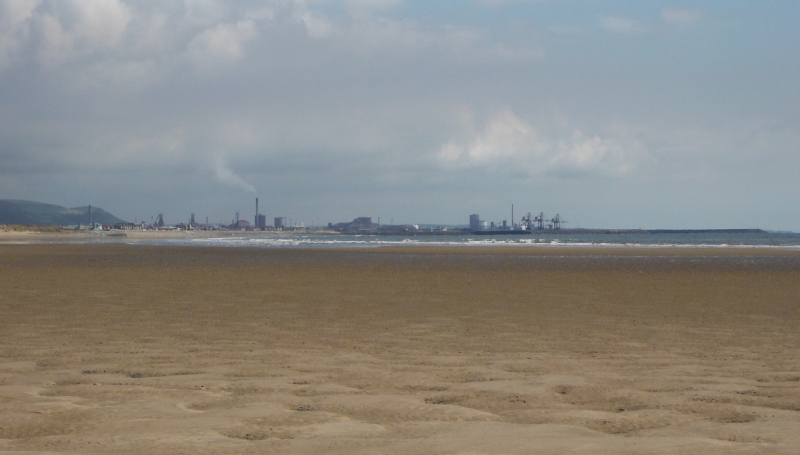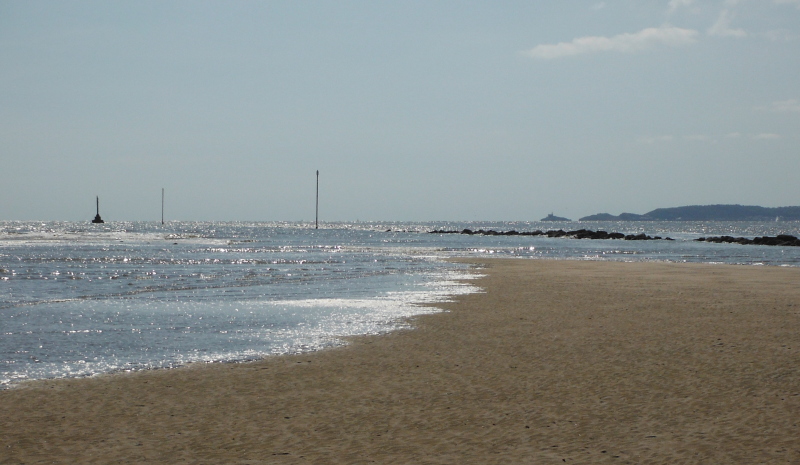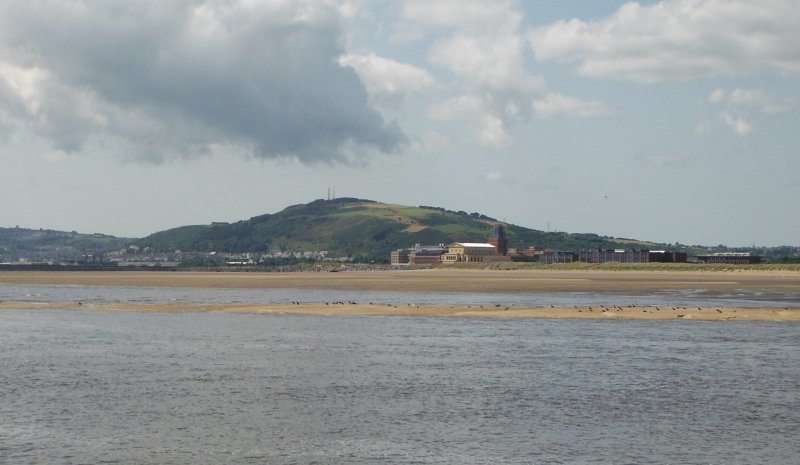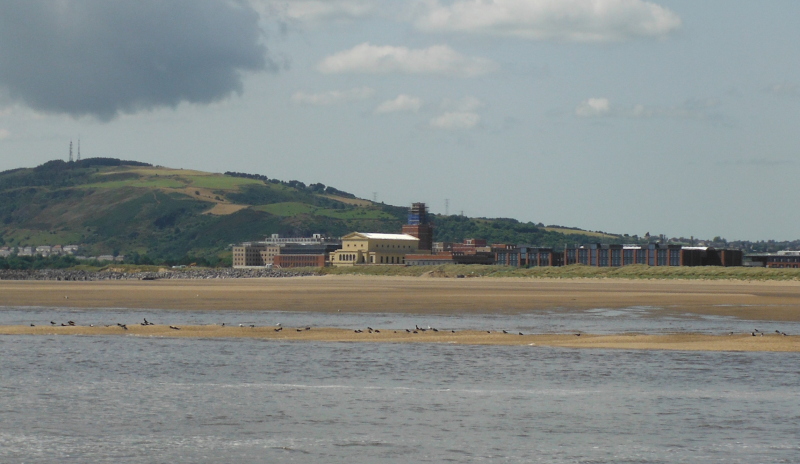out and about - 2015
20 July 2015 .............. Witford Point
Witford Point is right along at the northwest end of Aberavon Sands, and is as far as you can go without getting wet - the River Neath gets in the way.
Looking back along Aberavon Sands towards the steel works -

Looking roughly southwest out beyond the outer marker across Swansea Bay over to Mumbles Head. At very low tides you can get right out to the marker.

And looking west along the innermost part of Swansea Bay, past Crymlyn Burrows, past the new Swansea University Bay Campus, and towards the docks.

It is an amazing place to build a university campus, right on the beach - the building works are still ongoing.

It is sad to think that these views of Swansea Bay are going to be changed by the proposed tidal lagoon - there has been quite a bit in the local press about the tidal lagoon, but very little in the national press.
The basic idea is that a seawall will be built right out into Swansea Bay - the wall is something like 9 kilometres long, and stretches out from the docks beside the River Tawe, round in a big deformed circle, and coming back to land somewhere to the east of the docks - but I don`t know exactly where.
As the tides rise and fall, the flow of water in and out of the lagoon will be used to generate electricity.
It was noticeable when reading the local press, and seeing how, when the lagoon was first proposed, various voices in Cardiff thought it was a great idea that Swansea Bay should be sacrificed to the god of renewable energy - then when the same company proposed another tidal lagoon in Cardiff Bay, suddenly the voices in Cardiff went very quiet.
Because of the size of the project, the decision whether it should be allowed had to be made by the Westminster government, rather than by the Welsh Government in Cardiff.
The coalition government prevaricated up to the election, and left it up to the next government to make the decision - one of the first things the Conservative government did after winning the election was to allow the project to go ahead. The Labour government in Cardiff has been very quiet about it.
It is maybe worth considering that Wales, like Scotland, is already a net exporter of electricity to England - Wales already makes more electricity that it uses - Wales doesn`t need any tidal lagoons to generate its electricity.
I must confess that I have considerable doubts about the desirability of the tidal lagoon.
One of the things that has had little publicity is showing just how much the lagoon is going to stick out into Swansea Bay - if the sea wall is 9 kilometres long, then the lagoon is roughly 3 kilometres in diameter, so it will stick out from the docks by about 3 kilometres - this is quite an intrusion into Swansea Bay.
I don`t think it is generally realised just how intrusive the lagoon is going to be.
It also seems strange to me that the followers of the climate change religion will advocate for any kind of development that produces renewal energy, and completely ignore the wholesale destruction of the environment that is going to occur in order to get the development.
Isn`t the quest for renewal energy about protecting the environment ?
Whilst it is clear that there is the potential to use tidal currents to produce electricity, building tidal lagoons seems to be an expensive and environmentally destructive way to do it.
-----------------------
In addition, I have several doubts about the long term viability of the lagoon -
===>
Firstly, its construction seems somewhat flakey to me - my understanding is that the wall is to be built up with soft material dredged up from the seabed, and then the outer edges of the wall are lined with rocks imported from, I think, Cornwall.
Now quite apart from the wholesale destruction of the sea bed and all the sea life that lives on it because of the dredging, the sea water and wave action will cause considerable water flow through the rocks, and will result in the soft sand in the middle getting washed out, and the outer barrier of rocks will progressively collapse inwards.
Maybe there is a technology that will prevent this erosion, but I haven`t seen any reference to it.
It is also well known that a rock barrier is not that effective in preventing damage both to the barrier itself as well as to the layers behind the barrier, as the rocks tend to move about. I wonder how the economics of the project would be affected if it turned out that they had to use tetrapods to create the barrier - a lot more expensive.
Not only that, but if in reality - rather than filling the wall with sand from the sea bed - the wall had to built totally from rocks that would have to be imported to the site from some other part of the country, then there would also be another significant increase in the cost of the project.
===>
Secondly, the various pictures of the proposed seawall show a flat top to the seawall to be used for walking and cycling, and presumably, also for vehicle access to the generators.
I predict that a good ten year storm and a high tide will rip off much of this flat top - if you don`t believe me, maybe you should go and speak to Aberystwyth - they didn`t think it would happen either.
===>
Thirdly, the seawall is going to have a significant effect on the tidal currents that flow around Swansea Bay - by interrupting the tidal currents, the areas of coast on either side of the landward ends of the seawall are going to have much less current, less current means that sand in suspension will drop to the seabed, and so there will be a subsequent build up of sand on the seabed, which will eventually lift above sea level, aided by the wind, which already manages to shift tons of sand inwards.
Swansea and Port Talbot can say bye bye to the sea.
Maybe they could use the new area of land which will be formed to build houses on - Swansea in particular has a considerable need of land for new housing.
You will be able to walk or cycle or drive along Mumbles Road and look out to a sea of houses, instead of looking out to Swansea Bay.
And just think of all the extra parking spaces that could be created.
===>
Fourthly - this same dropping of sand will occur inside the lagoon, because inside the lagoon there will be little current - so the seabed level inside the lagoon will rise - as it rises, less water flows through the turbines on each tide cycle, so the amount of electricity generated will progressively reduce - eventually to zero.
Unless of course the lagoon is regularily dredged - I am not quite sure how you would get a dredger in there, but perhaps they can work something out.
Maybe they could use a fleet of diggers at low tide - but then what would they do with all the sand ?
I guess that they could dump it outside the sea wall - that would help the land reclamation project along nicely.
===>
Lastly, something I have noticed is that the seawater in this area - particularily along by Witford Point which is close to the site of the proposed lagoon - isn`t nice clean water, it is heavily contaminated by fine sand in suspension - and I reckon that this sand in suspension will have a considerable effect on the generators, by acting as grinding paste and destroying seals and bearings.
I wonder if the business plan includes regular expenditure on replacement generators.
===>
Once the construction of the tidal lagoon starts, Swansea Bay will be changed for ever.
Bye bye Swansea Bay.
It is a sad reflection on the attitude of big business and investment houses that they are quite happy to support and invest in a project that is going to change an area like Swansea Bay to this extent, and is going to have such an environmental impact - the only thing that matters is profit.
The hunger for profit is what is driving this project, renewable energy is just a convenient platform to utilise for this.
Incidentally, even if you don`t live in South Wales it is worth being aware of what is going on, because the same company has proposed six tidal lagoons around the UK - four in Wales, one in England, and one in Scotland - although I am not sure about the actual locations.